Instrumental

An exhibition from the Physics Collection in the University Library
28 February - 12 May 2002
Physics has been taught at this University since it was first founded in 1882 as University College Dundee. J E A Steggall was appointed the first Professor of Natural Philosophy (as Physics was then called) and Mathematics. Steggall remained in the Chair of Mathematics for over half a century, but J P Kuenen took over the teaching of Physics in 1895, following the establishment of a Harris Chair of Physics (named after the wealthy college benefactors William and Margaret Harris).
During the first decade of the twentieth century, an appeal was launched for a new Science School. One local businessman who offered to help was James K Caird, famous for the Caird Hall in Dundee's city centre. He offered expansive plans for a Physics laboratory that extended out onto Perth Road, but the College Council turned them down in 1905.
Instead the Council sought to develop the land behind their two houses on Perth Road (Ellenbank and Union Mount). A quadrangle was designed with Physics to the west and Engineering to the north. It was later named the Geddes quadrangle after the celebrated Professor of Botany.
The eminent Sir Rowand Anderson was appointed as architect for the new building, but Prof Kuenen clearly had a considerable influence on its design. No ironwork was to be used in the construction to avoid interference with magnetic experiments. The University Rector Andrew Carnegie agreed to cover the £12,500 cost, and the building still bears his name today.
On taking over the Physics Chair from Kuenen in 1907, William Peddie's first two years were spent preparing for the new building. He defended rising costs, claiming that "some such excess is the almost universal and inevitable rule in these cases." His labours were justified, however - in 1908 Steggall claimed that the result "presents a dignity so great and so characteristic that we begin to dream of extensions to harmonise with this beautiful building."
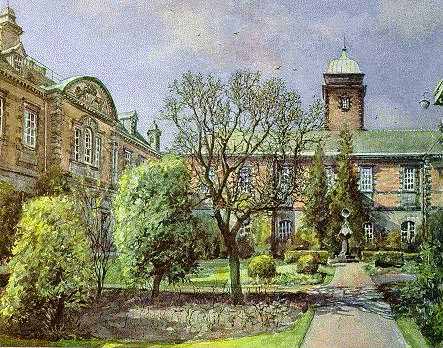
'The Geddes Quadrangle' by James McIntosh Patrick, 1983
The Carnegie laboratory was officially opened on 26 November 1909 by Sir J J Thomson, the discoverer of the electron. It had originally been proposed to link the Physics and Engineering buildings with a corridor, but Kuenen had put a stop to the idea. Instead, work began on the building of an Electrical Engineering laboratory to occupy the empty corner. It was named the Peters Building after the principal donor, and was opened by the father of nuclear physics, Ernest Rutherford.
Electrical Engineering remained part of Physics until a separate chair was established in 1947 (by which time G D Preston had succeeded Peddie). In 2000, however, the two subjects were merged again as the Department of Electronic Engineering & Physics. By that time Physics had left Carnegie and moved across the quadrangle to the renamed Harris Building. In 2006 the Carnegie Building became home to the Centre for Energy, Petroleum and Mineral Law & Policy.
Below are some of the objects featured in the exhibition...
Spectroscope
Around 1802, William Hyde Wollaston noticed that there were some dark lines crossing the spectrum produced by his prism. He misinterpreted them, but his work was taken up by others including J F W Herschel, who discovered that the lines were made by the absorption of light by different elements, thus allowing a unique pattern of light and dark lines for every molecule. To see these lines more accurately, Herschel devised a spectroscope consisting of a lens and prism. This was later improved by Anders Jonas Angstrom with his introduction of fine-cut glass gratings, which spread the spectrum more widely, thus allowing more detailed observation.

'Spectroscope' - A Kruss, Hamburg c.1910s

'Geissler Tubes' - Becker & Co, London c.1920s
Geissler Tubes
Johann Geissler was a glassblower at the University of Bonn and in the 1850s designed these extremely delicate tubes to demonstrate the phenomenon of electrical discharge in gases, effectively designing the precursor to neon signs.
Sextant
The sextant derives its name from the fact that the instrument has an arc that is one sixth of a circle and is calibrated from 0 to 120 degrees. It was invented in 1758 by Admiral John Campbell as a more accurate version of the Octant, and was used in sailing to calculate the altitude of fixed objects like the Moon, and thus approximate the position of latitude. In teaching physics it would have been an excellent instrument for calculating the altitude of any object fairly accurately.
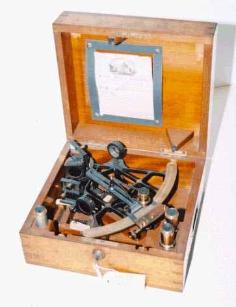
'Sextant' - c.1910s
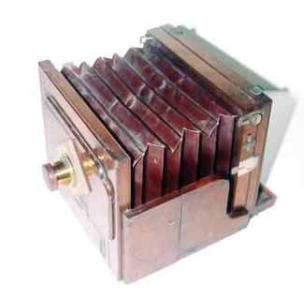
'Camera Obscura' - Ross of London, c.1900s
Camera Obscura
The Camera Obscura has been around since at least the seventeenth century when it is thought that the Dutch artist Vermeer used the apparatus to sketch out his paintings. Designed primarily as an optical trick, this gadget was procured by those who desired to sketch but didn't have the natural ability on their sight alone. In physics it was used to demonstrate light and the ability to project a scene onto a screen for viewing.
Madgeburg Hemispheres
These hemispheres were originally designed in 1650 by Otto von Guericke to demonstrate the presence of a vacuum and its force at a time when a vacuum was believed to be non-existent. By butting two hemispheres together and pumping the air out, a suction is created that requires a large force to pull the two apart - thus providing a basic demonstration of the presence of a vacuum.
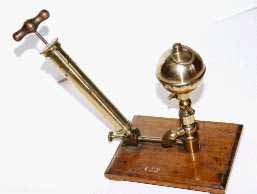
'Madgeburg Hemispheres' - c.1890s
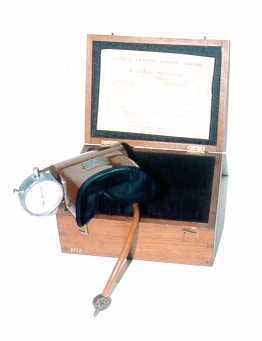
'Beta Model Stroboscope'
- Baird & Tatlock, London c.1930s
Beta Model Stroboscope
When hooked to an air compressor, this apparatus spins discs in front of the eyes creating a strobe effect. The stopwatch was used to time events during an experiment.
Sine Galvanometers
The earliest galvanometers were invented by S M Pouillet in the early 19th century to prove Ohm's Law that the current of a circuit is proportional to the voltage and inversely proportional to the resistance. The current flowing through a copper hoop or coil of wire deflects a compass needle in the centre.
If the instrument is rotated to return the compass to zero, an angle measurement is made between the table and the instrument. The sine of the angle is then proportional to the current, thus proving Ohm's Law.
Find out more in the Physics Collection page and the Made to Measure exhibition site.

'Sine Galvanometers' - c.1880s & c.1910s